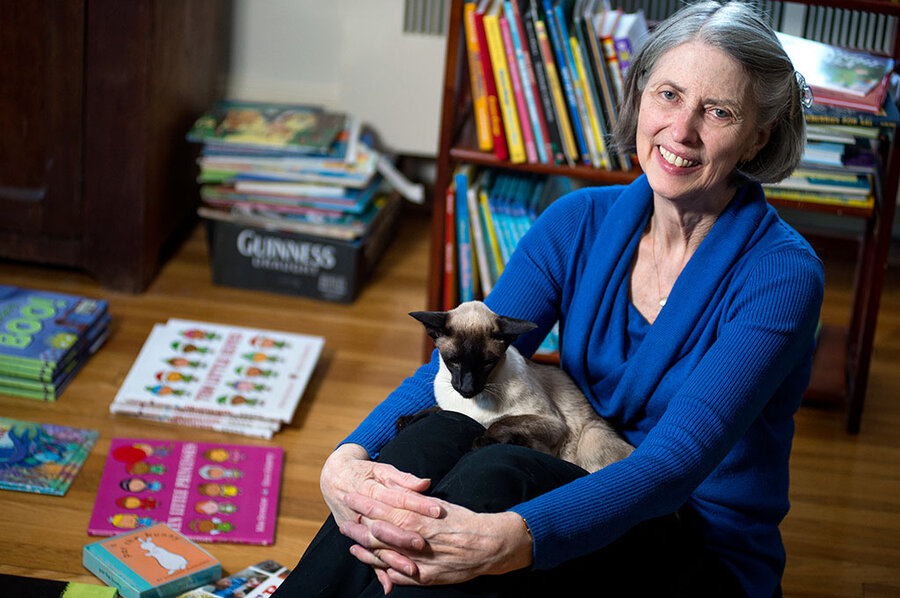How a mother-daughter duo has helped inmates read with their kids
Loading...
| Needham and Boston, Mass.
Tough male inmates who take Diana Barbero’s parenting courses at Boston’s Suffolk County House of Correction can’t help feeling a crack in their armor when in her cheerful classroom crammed with parenting magazines, colorful children’s posters, and a baby doll to practice holding.
Ms. Barbero’s prized possessions in this prison oasis are the brand-new children’s books supplied by A Book From Dad, a program that distributes donated books to incarcerated fathers to give as gifts to their children.
In turn, those books often become a prized family possession – a tangible connection between a parent and child who have limited or no personal contact.
And Barbero offers prime evidence of that tender thread: “I met a teacher from the Boston Public Schools who had a second-grader bring in a book and say proudly, ‘My father sent me this from prison!’ ”
Similarly, west of Boston at MCI-Framingham, a women’s prison, dozens of incarcerated mothers receive and give a book to their children each week during family visits through A Book From Mom, as the program is known there, says Kylee Green, the prison’s family preservation program director.
Through the program, more than 30,000 new children’s books have been handed from parent to child at Boston-area prisons since 2004, when Jane Handel, an eighth-grader in Needham, Mass., hatched the idea as a school volunteer project.
How a program like this in the gritty corrections system started in the mind of a suburban eighth-grader was “serendipity,” says Jane’s mother, Elizabeth Handel. It was the coincidence of the family’s intense love of books, brainstorming to come up with volunteer hours for school, and a family friend’s vivid description of her social work with incarcerated women.
Jane overheard the friend say that women were separated from their children, and Jane felt bad that mothers and their children couldn’t read together as she and her mother did at home.
“I was so lucky growing up; every night my mom and I read a stack of books together,” she says. “[But incarcerated mothers] don’t have the luxury of running out to the library and picking up a book and reading it. [They] are serving time, but their kids are doing time, too,” without their parents.
This, Elizabeth says, was the “epiphany” that got Jane beyond the “criminal” label to see that “these were people who had families ... and then she got the idea that maybe they could use some books so that they could read to their kids.”
Teen volunteer projects
It’s a familiar quest for US teens to land a volunteer project that ideally seeds civic consciousness while logging the long hours required for graduation and a stellar college résumé. Whether it’s raising money for wells in Africa, building schools in Haiti, or being shuttled by Mom to the local community center once a week, teen projects mostly begin and end before high school graduation.
But Jane’s project had no built-in expiration date, and A Book From Mom proved such a lean, easy, and successful proposition that it never lost momentum, even as Jane went off to college and a marketing career in New York City. Her mother – a busy doctor in Needham, Mass. – was an essential partner from the beginning as chauffeur and adviser. She’s become the primary book collector and distributor, while Jane searches for new sources of books, manages the social media, and communicates with regular donors.
What does it take to keep the program running? “Not much,” deadpans Elizabeth. “That’s the beauty of it.”
“There are people who put their heart and soul into volunteer work; they’re working day and night ... but that would not fit into our life,” she says.
From the beginning, she explains, the plan was to avoid complexity – no collection of money, no overhead such as shipping or solicitation, and no organizational formalities like bookkeeping and nonprofit status. The program simply was a 13-year-old (with the help of her mom) collecting new books locally and distributing them to local correctional facilities – with the mandate that the books pass between parent and child and not pile up in a prison library, and that parents have a selection of books to choose from.
‘These are gifts’
A Book From Mom/Dad is a constant drive for new book donations, Elizabeth says. “We go to a lot of trouble to offer only new books, and we fend off a lot of used books, because people think that should be OK, but they’re used – these are gifts.”
Boxes of books – from standards like “Pat the Bunny” and Dr. Seuss titles to publishers’ remainders of what Elizabeth calls “not great literature” – wax and wane in the large living room of the Handels’ historical 1779 home. During the holiday giving season, the room – and others in their house – can be completely full. The more books, the stronger the book smell, she says.
A large part of the job is sorting the books into age groups and culling out the inappropriate (such as “Little Police Car,” a board book that shows police picking up criminals).
Over the years, books have flowed steadily from individual donors – such as a girl who brought in 700 books by asking that gifts for her bat mitzvah be books for the program. Local publishers often give large amounts. And a local Barnes & Noble generated huge influxes by creating attractive store displays and asking customers at the checkout counter if they would like to donate one of a series of preselected books.
As Jane wrote in a high school report on her project: “I have found the donations that come from children are the most moving, as they tuck little paper messages and bookmarks into their own favorite titles – ‘Happy Reading,’ or ‘You’ll love this book.’ ”
Each shared book, say those involved with the program, represents a positive interaction between a parent and child.
“A lot of times when someone is incarcerated ... they’re so concerned with what’s going on in their own life that they don’t consider the impact on their kids,” says Jim Dizio, head of education at the Suffolk County prison.
The Book From Dad program, he explains, is a “puzzle piece” that fits perfectly, nurturing father-child relationships and promoting literacy in both the adult and child. Barbero helps fathers record themselves reading from the books and includes a CD with each book so kids can hear their dads reading to them.
While the program at Suffolk involves gift-wrapping books and mailing them to children, contact visits at medium-security MCI-Framingham allow mothers to read their gift to a child sitting on their laps.
Having a book to read and give, Ms. Green says, brings a measure of normalcy to a mother and child “like it was back before they were here. It gives them an opportunity to be a normal parent just reading to their kid, talking with their kid about the book.... It’s important not just to the parent, but for the kid to feel that bond.”
Appreciation from inmates
The Handels, who deliver books to prison officials or have prison officials pick them up, have never witnessed that connection personally because they do not go inside the facilities. But they do get feedback.
“It is something that has allowed me to show my child that even though I’m not physically there with him, I still think and care very much so!” one incarcerated mother wrote to the Handels.
Perhaps the hardest part, Jane says, was making contact with prisons. But she says the key was perseverance in identifying, deep within the corrections bureaucracy, the overworked but caring family educators and social workers who understand how the books can build literacy and how reading together can strengthen family bonds.
The “power of books,” says Elizabeth, is the motivator that initiated the program and keeps it going. Putting that power for good in the hands of parents in prison is important. “Imagine being a parent who can’t give,” she says of incarcerated parents. Giving them a book to give a child is “the most natural thing in the world.”
• This program can be reached at abookfrommom@gmail.com.
How to take action
UniversalGiving helps people give to and volunteer for top-performing charitable organizations around the world. All the projects are vetted by UniversalGiving; 100 percent of each donation goes directly to the listed cause. Below are links to three groups that support reading, children, or both:
Literacy Partners has a two-generation approach to education that includes free classes for low-income parents in New York City to work on their literacy and language skills. Take action: Donate to the program Books of Their Own.
Benetech develops innovative and effective technology applications for unmet social needs. Take action: Help fund a digital library for people who can’t read a printed book because of disabilities.
Childhelp Sierra Leone uses advocacy, development, and relief to address the needs of youths in distressed communities. Take action: Volunteer with this organization, focusing on justice for girls.








